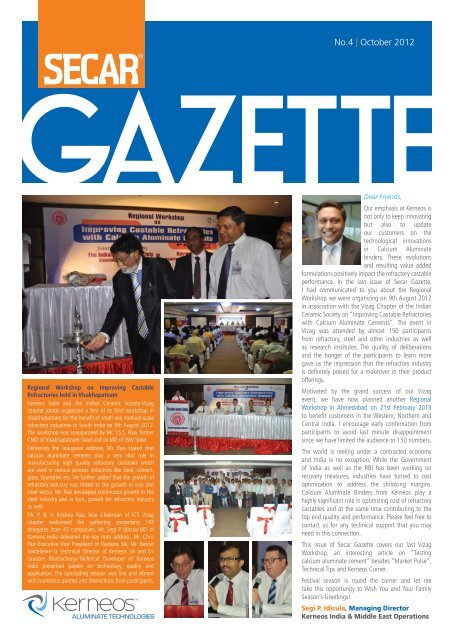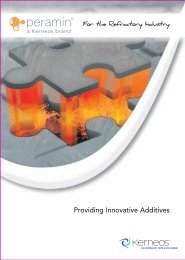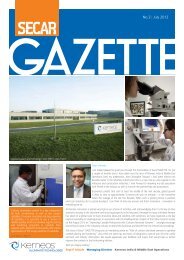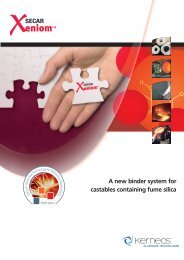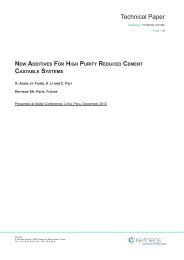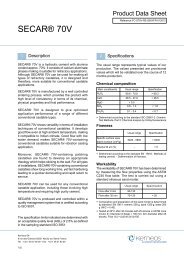News Latter VOL_4.indd - SECAR®, solutions for refractories
News Latter VOL_4.indd - SECAR®, solutions for refractories
News Latter VOL_4.indd - SECAR®, solutions for refractories
You also want an ePaper? Increase the reach of your titles
YUMPU automatically turns print PDFs into web optimized ePapers that Google loves.
No.4 | October 2012<br />
Regional Workshop on Improving Castable<br />
Refractories held in Visakhapatnam<br />
Kerneos India and the Indian Ceramic Society-Vizag<br />
chapter jointly organized a first of its kind workshop in<br />
Visakhapatnam <strong>for</strong> the benefit of small and medium scale<br />
refractory industries in South India on 9th August 2012.<br />
The workshop was inaugurated by Mr. Y.S.S. Rao, <strong>for</strong>mer<br />
CMD of Visakhapatnam Steel and ex MD of JSW Steel.<br />
Delivering the inaugural address, Mr. Rao stated that<br />
calcium aluminate cements play a very vital role in<br />
manufacturing high quality refractory castables which<br />
are used in various process industries like steel, cement,<br />
glass, foundries etc. He further added that the growth of<br />
refractory industry was linked to the growth of iron and<br />
steel sector. Mr. Rao envisaged continuous growth in the<br />
steel industry and in turn, growth <strong>for</strong> refractory industry<br />
as well.<br />
Mr. P. B. V. Krishna Rao, Vice Chairman of ICS Vizag<br />
chapter welcomed the gathering comprising 143<br />
delegates from 43 companies. Mr. Segi P Idicula-MD of<br />
Kerneos India delivered the key note address. Mr. Chris<br />
Parr-Executive Vice President of Kerneos SA, Mr. Benoit<br />
Valdelievre-Sr. Technical Director of Kerneos SA and Dr.<br />
Goutam Bhattacharya-Technical Developer of Kerneos<br />
India presented papers on technology, quality and<br />
application. The concluding session was live and vibrant<br />
with numerous queries and interactions from participants.<br />
Dear Friends,<br />
Our emphasis at Kerneos is<br />
not only to keep innovating<br />
but also to update<br />
our customers on the<br />
technological innovations<br />
in Calcium Aluminate<br />
binders. These evolutions<br />
and resulting value added<br />
<strong>for</strong>mulations positively impact the refractory castable<br />
per<strong>for</strong>mance. In the last issue of Secar Gazette,<br />
I had communicated to you about the Regional<br />
Workshop we were organizing on 9th August 2012<br />
in association with the Vizag Chapter of the Indian<br />
Ceramic Society on “Improving Castable Refractories<br />
with Calcium Aluminate Cements”. The event in<br />
Vizag was attended by almost 150 participants<br />
from refractory, steel and other industries as well<br />
as research institutes. The quality of deliberations<br />
and the hunger of the participants to learn more<br />
gave us the impression that the refractory industry<br />
is definitely poised <strong>for</strong> a makeover in their product<br />
offerings.<br />
Motivated by the grand success of our Vizag<br />
event, we have now planned another Regional<br />
Workshop in Ahmedabad on 21st February 2013<br />
to benefit customers in the Western, Northern and<br />
Central India. I encourage early confirmation from<br />
participants to avoid last minute disappointment<br />
since we have limited the audience to 150 numbers.<br />
The world is reeling under a contracted economy<br />
and India is no exception. While the Government<br />
of India as well as the RBI has been working on<br />
recovery measures, industries have turned to cost<br />
optimization to address the shrinking margins.<br />
Calcium Aluminate Binders from Kerneos play a<br />
highly significant role in optimizing cost of refractory<br />
castables and at the same time contributing to the<br />
top end quality and per<strong>for</strong>mance. Please feel free to<br />
contact us <strong>for</strong> any technical support that you may<br />
need in this connection.<br />
This issue of Secar Gazette covers our last Vizag<br />
Workshop, an interesting article on “Testing<br />
calcium aluminate cement” besides “Market Pulse”,<br />
Technical Tips and Kerneos Corner.<br />
Festival season is round the corner and let me<br />
take this opportunity to Wish You and Your Family<br />
Season’s Greetings!<br />
Segi P. Idicula, Managing Director<br />
Kerneos India & Middle East Operations
Market Pulse<br />
Infrastructure Projects in India delayed<br />
India’s infrastructure sector has been in<br />
the doldrums <strong>for</strong> quite some time now<br />
because of huge delays in infrastructure<br />
projects. The finance ministry estimates<br />
that infrastructure projects worth Rs.1.46<br />
lakh crore have been delayed.<br />
• In the road sector, projects have<br />
been delayed because of land acquisition<br />
and environmental issues. Sixteen major<br />
highway projects worth Rs.15,000 crore<br />
in four states have been stalled, awaiting<br />
environmental clearances from the Ministry<br />
of Environment and Forests (MoEF). Delays<br />
in obtaining environmental clearance<br />
have stalled many crucial coal production<br />
projects.<br />
• Delay in capacity expansion at various<br />
ports is taking a toll on exporters and<br />
importers. The fourth container terminal at<br />
Jawaharlal Nehru Port Trust is delayed and<br />
facing obstructions. The Rs.6,700 crore<br />
project is said to have a capacity of 4.8<br />
million containers a year.<br />
• The South Korean steel giant Posco is<br />
facing major roadblocks in completion of<br />
its 12-million tonne mega steel project in<br />
Odisha.<br />
Government of India has planned to take<br />
measures to boost infrastructure growth<br />
after the record low GDP growth of 5.3%<br />
witnessed in the January-March quarter<br />
of 2012. Prime Minister announced the<br />
setting up of an investment-tracking system<br />
which will review projects periodically to<br />
ensure that issues are quickly identified<br />
and resolved.<br />
The Prime Minister said, “The government<br />
alone cannot invest this amount. There<strong>for</strong>e,<br />
importance is being given to public-private<br />
partnership.<br />
New National Steel Policy<br />
In view of changed economic environment,<br />
both globally as well as domestically,<br />
Ministry of Steel has initiated the process<br />
of drafting the New National Steel Policy<br />
in place of existing National Steel Policy<br />
2005. An Apex Committee, headed<br />
by Secretary, Ministry of Steel and<br />
consisting of representatives of Planning<br />
Commission, Ministries/ Departments of<br />
Central Government and concerned State<br />
Governments has been constituted <strong>for</strong><br />
monitoring the process of <strong>for</strong>mulation<br />
of the New National Steel Policy. Four<br />
Task Forces have been constituted under<br />
the Chairmanship of eminent experts to<br />
study, analyze, consult and <strong>for</strong>mulate<br />
draft policy documents in different aspects<br />
of the subject. These task <strong>for</strong>ces are<br />
currently in various stages of discussion<br />
and consultation with the stakeholders<br />
and experts in the industry to identify all<br />
the relevant issues and come up with the<br />
policy prescriptions. A final view on the<br />
New National Steel Policy will be taken on<br />
receipt of reports.<br />
The new steel policy will be put in place<br />
in six months to facilitate rapid growth of<br />
the domestic steel sector by ensuring faster<br />
capacity addition. “A Steel Ministry panel,<br />
constituted to frame the new Steel Policy<br />
will finalise the draft in two months,”as<br />
in<strong>for</strong>med by Joint Secretary Steel during<br />
Steel Summit held at New Delhi in<br />
March’12.<br />
Tech Edge<br />
The shelf life guarantees <strong>for</strong><br />
Secar ® 68V and Secar ® 70V<br />
were established at 6 months<br />
based on initial testing of<br />
laboratory, pilot scale and<br />
full production batches.<br />
Further to more extensive<br />
testing conducted over<br />
extended time periods and<br />
coupled with improvements<br />
to the packaging used, the<br />
shelf life <strong>for</strong> Secar ® 68V and<br />
Secar ® 70V is extended to<br />
9 months. However, the<br />
storage condition should be<br />
appropriate, as explained in<br />
the product data sheet - in<br />
common with all hydraulic<br />
binders, SECAR ® 68V and<br />
Secar ® 70V must be stored<br />
in shrink wrapped condition<br />
on pallet, as supplied, in dry<br />
conditions under a covered<br />
storage area.<br />
During the test program,<br />
the products were packed<br />
in standard bags and on a<br />
shrink wrapped pallet with 5<br />
layers. Samples were stored<br />
in a warehouse in Singapore<br />
(high ambient temperature<br />
and humidity) and sacks<br />
returned to KDCC (Kerneos<br />
Development Centre,<br />
China) each month <strong>for</strong><br />
testing. The products were<br />
well packed and stocked<br />
according to best practice<br />
(on pallet, off the ground,<br />
with shrink wrapped film in<br />
a ‘dry’ warehouse). After a<br />
bag was removed the plastic<br />
film of the pellet was closed<br />
to avoid exposure of bags to<br />
the air.<br />
The mortar and application<br />
test of flow, setting and<br />
strength (6h and 24h)<br />
showed that there was<br />
less than 5% change in<br />
properties from time zero to<br />
9 to 12 month storage. This<br />
variation is almost within<br />
the normal variation of the<br />
test method.<br />
Kerneos Corner<br />
Environmental Clearance <strong>for</strong><br />
Kerneos India Project<br />
Following the acquisition of a<br />
piece of land of 8.3 hectares in<br />
February 2012, Kerneos was<br />
granted in August 2012 the<br />
Environmental Clearance <strong>for</strong> the<br />
project by the state environment<br />
authorities. This is a key milestone<br />
in the construction of the new<br />
Kerneos plant in India, scheduled<br />
to start operation by the end of<br />
2014.<br />
This green field sintering unit of<br />
30,000 tons per year capacity<br />
dedicated to the manufacture<br />
of calcium aluminate cements<br />
<strong>for</strong> refractory applications will<br />
be established in the area of<br />
Visakhapatnam city in Andhra<br />
Pradesh and will produce a<br />
range of high quality products<br />
specifically designed <strong>for</strong> the<br />
Indian market needs.<br />
Regional Workshop in<br />
Ahmedabad in February, 2013<br />
Kerneos is organizing a regional<br />
workshop on Calcium Aluminate<br />
Cement based Castable Technology<br />
and its Application in Ahmedabad,<br />
Gujarat on Thursday, 21st February,<br />
2013 in association with the Indian<br />
Ceramic Society Gujarat Chapter.<br />
Prime objective is to share in<strong>for</strong>mation<br />
on the latest castable technology<br />
and main focus will be the Refractory<br />
manufacturing industries in Western,<br />
Northern and Central India.
TESTING CALCIUM ALUMINATE CEMENT<br />
G. Bhattacharya*, B. Valdelièvre* and C. Parr.<br />
*Kerneos, Kolkata, India<br />
INTRODUCTION<br />
Cement tests, if required, need to be done carefully<br />
to ensure accuracy of the results. Often neat<br />
cements are used <strong>for</strong> testing without a suitable<br />
temperature control. Neat cement tests generally<br />
give higher variability than standard sand mortar<br />
tests. This is because of the difficulty of nucleation<br />
of calcium aluminate hydrates in absence of<br />
nucleating surfaces <strong>for</strong> the neat cement paste.<br />
Also, cement hydration is temperature dependent<br />
and the setting shows anomalous nature between<br />
~24°-28°C, making temperature control essential<br />
<strong>for</strong> cement testing. Besides, appropriate choice of<br />
ambient temperature (20°C) is essential to ensure<br />
that the test does not bring additional variability.<br />
Moreover, there is no direct correlation between<br />
cement and castable setting, particularly <strong>for</strong><br />
deflocculated castables, which are influenced by<br />
additives and other bond phase materials.<br />
Last year during a technical meeting, a customer<br />
told us that when he tested a calcium aluminate<br />
cement, he found its results were completely<br />
unsatisfactory and they were almost deciding not<br />
to use the cement. However, when they tested the<br />
cement in one of their products, it gave excellent<br />
results and the tests on bulk production lots were<br />
equally good. Often the answer lies in testing<br />
calcium aluminate cement appropriately.<br />
Despite these major issues on testing cements<br />
properly, there is almost a consensus among<br />
castable manufacturers of India that cement needs<br />
to be tested regularly. Cement is considered too<br />
important a raw material to be left completely<br />
untested. The key objective is of course to monitor<br />
quality of the cement lot. Some even think that<br />
they should be able to correlate cement properties<br />
with those of castables. For cements there is no<br />
universally accepted test method. In this article, a<br />
few key factors of cement tests, which influence<br />
the results, will be discussed.<br />
SET TIME TEST - NEAT PASTE VS. MORTAR<br />
Neat paste test has been popular in India <strong>for</strong> long,<br />
which was followed in many parts of the world<br />
earlier. However, this test was updated to mortar<br />
test. Set time and exo peak time variations of<br />
Secar 71, a 70% alumina cement are compared<br />
by mortar (Figure 1a and b) and neat paste tests<br />
(Figure 1c and d) at 20°C using seven random<br />
samples. The set time tests were conducted using<br />
an automatic Vicat needle, which is programmed<br />
to fall at specified intervals, ensuring high accuracy<br />
of the results. AFNOR (EN 14647) sand was used to<br />
make the mortar and ratio of sand: cement: water<br />
was 6:2:1. Neat cement test results with both Vicat<br />
and exo peak showed higher variation than those<br />
with the mortar, indicating high inherent variability<br />
of the neat cement test, which can be explained<br />
Setting (mins)<br />
Setting (mins)<br />
250<br />
200<br />
150<br />
100<br />
50<br />
0<br />
400<br />
350<br />
300<br />
250<br />
200<br />
150<br />
100<br />
50<br />
0<br />
210<br />
198<br />
190<br />
Initial set<br />
195<br />
200<br />
190<br />
200<br />
1 2 3 4 5 6 7<br />
250<br />
190<br />
278<br />
Time (hrs)<br />
4.57<br />
4.88<br />
4.45 4.5 4.5<br />
a) b)<br />
Initial set<br />
200<br />
310<br />
375<br />
200<br />
1 2 3 4 5 6 7<br />
Time (hrs)<br />
c) d)<br />
6<br />
5<br />
4<br />
3<br />
2<br />
1<br />
0<br />
20<br />
18<br />
16<br />
14<br />
12<br />
10<br />
8<br />
6<br />
4<br />
2<br />
0<br />
Exo max<br />
4.21<br />
5.05<br />
1 2 3 4 5 6 7<br />
9.85<br />
11.5<br />
Exo max<br />
10.8<br />
6.6<br />
8.7<br />
18.8<br />
1 2 3 4 5 6 7<br />
Figure 1: Variation of a) initial set time and b) exo peak time in a set of random Secar 71<br />
samples using AFNOR mortar test and those (c and d respectively) with neat paste test<br />
by the mechanism of cement hydration reaction<br />
(Figure 2).<br />
hydrates<br />
ionic concentration<br />
1 2 3<br />
time<br />
exotherme<br />
Figure 2: Mechanism of cement hydration<br />
reaction<br />
The first step includes dissolution of cement<br />
particles in water leading to rapid increase of<br />
ionic concentration, little hydrate <strong>for</strong>mation and<br />
no temperature increase. The second step is<br />
nucleation, when ionic concentration starts to<br />
decrease slowly, hydrates start to appear and again<br />
no temperature increase is observed. The final<br />
stage is massive precipitation of hydrates which<br />
shows rapid drop in ionic concentration, increase<br />
in hydrates and exothermic peak.<br />
Nucleation of cements with large amount of<br />
Figure 3: Presence of nodules in Secar 71<br />
neat paste sample (w/c=0.27) after washing<br />
between initial and final setting (from<br />
Lafarge laboratories in 1960s)<br />
calcium aluminate (CA) phase (such as Secar 71)<br />
is difficult as it takes place homogeneously from<br />
solution and presence of nucleation sites help<br />
reducing nucleation time. Pure CA nucleation<br />
takes 13-20h. Difficult nucleation of Secar 71 leads<br />
to nodules which are often visible (Figure 3). C 12<br />
A 7<br />
,<br />
fine fillers such as sand and lithium ions generate<br />
nucleation sites decreasing set time. The cements<br />
with more C 12<br />
A 7<br />
are found to be more regular in<br />
neat cement test than those with less C 12<br />
A 7<br />
, as<br />
shown in the conductivity plots of several samples<br />
7.5
mS/cm<br />
Time minutes<br />
350<br />
300<br />
250<br />
200<br />
150<br />
100<br />
50<br />
AFNOR MORTAR<br />
0<br />
0 2 4 6 8 10 12 14 16 18 20 22 24 26 28 30 32 34 36 38 40 42 44 46 48 50<br />
Temperature°C<br />
Figure 5: Initial set time of a 70% alumina<br />
cement as a function of ambient temperature<br />
Temperature°C<br />
2,8<br />
2,6<br />
2,4<br />
2,2<br />
2<br />
1,8<br />
1,8<br />
A<br />
10 min<br />
120 min<br />
1,4<br />
0 60 120 180 240 300 360 420 480 540 600 660<br />
Time (min)<br />
Figure 4: Variation of conductivity of<br />
two calcium aluminate cements (random<br />
samples) – A & B as a function of time; A<br />
has more C 12<br />
A 7<br />
than B.<br />
of two cements – A with more C 12<br />
A 7<br />
than B<br />
(Figure 4).<br />
VARIATION OF SET TIME AS A FUNCTION OF<br />
TEMPERATURE – ANOMALOUS SETTING<br />
Cement hydration reaction is temperature<br />
dependent. It is generally expected that with<br />
T°C<br />
50<br />
45<br />
40<br />
35<br />
30<br />
25<br />
20<br />
15<br />
10<br />
5<br />
0.5 1.5 2.5 3.5 4.5 5.5 6.5 7.5 8.5 9.5<br />
Time hours<br />
42°C<br />
35°C<br />
32°C<br />
28°C<br />
25°C<br />
20°C<br />
12°C<br />
8°C<br />
Figure 6: Variation of exo peak temperature<br />
a 70% alumina cement as a function of<br />
ambient test temperature<br />
increase in ambient temperature the reaction<br />
will be rapid and set time will decrease. Calcium<br />
aluminate setting as a function of time is not<br />
very simple. Figure 5 shows that setting time of<br />
a 70% alumina cement decreases from 5°C to<br />
20°C, remains almost stable up to ~24°C and then<br />
increases till 30°C, which is followed by a rapid<br />
B<br />
<br />
<br />
Increase of solubility<br />
decrease of supersaturation<br />
<br />
28°C<br />
<br />
Acceleration of<br />
nucleation by temperature<br />
°<br />
Figure 7: Evolution of nucleation time of<br />
CAH 10<br />
and AH 3<br />
with temperature<br />
drop above this temperature. The exo profiles<br />
and the peak temperatures times also reveal the<br />
similar behavior of the calcium aluminate cement<br />
(Figure 6). This unexpected increase of set time<br />
or anomalous setting from ~24°C to 28-30°C is<br />
common in pure calcium aluminate cements and<br />
is absent or less prominent with 80% aluminacontaining<br />
cements which may contain additives<br />
and alumina. The anomalous setting may be<br />
explained by an increase in solubility of CAH 10<br />
,<br />
which <strong>for</strong>ms predominantly below 28°C. Increased<br />
solubility leads to a decrease in supersaturation<br />
and there<strong>for</strong>e, difficulty in nucleation. Above 28°C,<br />
(C 2<br />
AH 8<br />
+AH 3<br />
) <strong>for</strong>m preferentially, as the nucleation<br />
of AH 3<br />
becomes quicker due to thermal activation<br />
and the solubility of AH 3<br />
does not change with<br />
increase in temperature (Figure 7).<br />
CORRELATION BETWEEN CEMENT AND CASTABLE<br />
SET TIME AT DIFFERENT TEMPERATURE<br />
PTT (min)<br />
3500<br />
3000<br />
2500<br />
2000<br />
1500<br />
1000<br />
500<br />
0<br />
PTT (min) Cement (AFNOR)<br />
PTT (min) low cement castable<br />
20 23 25 28 30 32 35 38 42 45<br />
Ambient temperature (°C)<br />
Figure 8: Variation of PTT (min) of cement<br />
and a low cement castable with this cement<br />
as a function of ambient temperature<br />
The cement set time may not be easily correlated<br />
with those of castables made from this cement. For<br />
conventional castables this relation may be relatively<br />
simple, although the nature of aggregates may<br />
bring some difference or variability, particularly <strong>for</strong><br />
those aggregates which bring soluble ions such<br />
as alkalis. The AFNOR sand is non reactive. The<br />
workability and setting reactions of deflocculated<br />
castables are influenced by fine fillers and additives<br />
and they behave quite differently from the<br />
cements, as a function of ambient temperature<br />
(Figure 8). Deflocculated castables do not show<br />
anomalous setting and their set times decrease<br />
steadily with increase in ambient temperature.<br />
CONCLUSION<br />
Cement setting test, although quite popular<br />
among the users, does not bring a major<br />
value due to major flaws in the test commonly<br />
practiced using neat cement without appropriate<br />
temperature control. Neat cement test often gives<br />
wide variability, particularly <strong>for</strong> CA-rich cements<br />
due to the difficulty to nucleate, which is an<br />
essential step just be<strong>for</strong>e precipitation of calcium<br />
aluminate hydrates. Nucleating surface generators<br />
help. Standard sand is often used <strong>for</strong> this purpose<br />
to make a mortar, which gives regularity in setting<br />
and is used widely all over the world. Also, it is<br />
important to choose the appropriate temperature<br />
of testing the setting of cement, as cement shows<br />
anomalous setting from ~24°C to ~28°C. 20°C<br />
may be considered as an appropriate temperature<br />
and is often used <strong>for</strong> testing calcium aluminate<br />
cement in most parts of the world and mentioned<br />
in major international standards (e.g. EN 14647). It<br />
is also essential to note that there is no simple 1:1<br />
correlation between cement and castable setting,<br />
particularly <strong>for</strong> deflocculated castables which are<br />
influenced by additives and other bond phase<br />
components. Considering all these aspects of<br />
cement tests, as all modern castable manufacturers<br />
in the world have adopted, it may be better <strong>for</strong> local<br />
manufacturers to stop testing cement and rely on<br />
the advance process and quality control systems of<br />
Secar products, which may be demonstrated with<br />
quality data. It may be easier and more effective<br />
<strong>for</strong> castable manufacturers to per<strong>for</strong>m application<br />
tests of calcium aluminate cement in standard<br />
castable composition.<br />
Kerneos India Business section is<br />
now available on our website. Please<br />
visit www.secar.net <strong>for</strong> access to<br />
technical papers, brochures, product<br />
data sheets of Indian as well as<br />
international products, all editions<br />
of Secar Gazette, FAQ etc.<br />
For more details mail : goutam.bhattacharya@kerneos.com<br />
Kolkata Office : KERNEOS INDIA<br />
3B – Shristi Bldg / 3rd Floor, 12, Ho Chi Minh Sarani, Kolkata 700 071, Tel: +91 33 3052 2315/16 Fax: +91 33 3052 2681<br />
Head Office : KERNEOS S.A<br />
8 Rue Des Graviers, 92521 Neuilly Sur Seine Cedex, France, Tel: +33 1 46 37 90 00 Fax: +33 1 46 37 92 00


